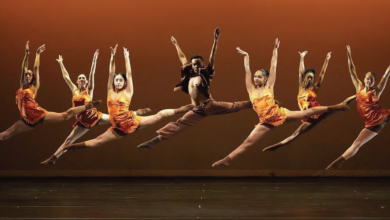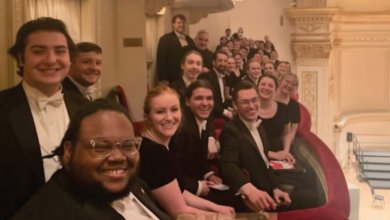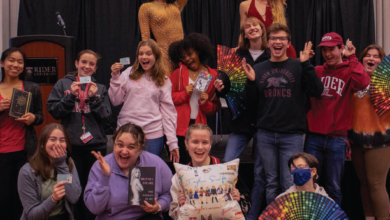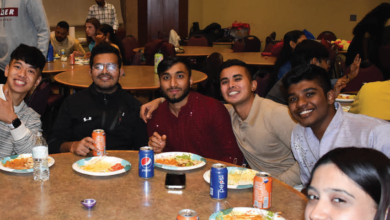
The tale of two broadcast worlds: 107.7 The Bronc & R.U.N.
By Sherrod Cotton Jr.
On Rider’s University’s campus, the Rider University Network (R.U.N.) and campus radio station 107.7 The Bronc—both of which make up the broadcast division – have been drastically affected by the unpredictable COVID-19 pandemic.
Since 2020, beyond course studies and curriculums, Rider has seen unprecedented changes and circumstances in athletics, annual events, activities, ceremonies, housing, clubs and organizations. Two prime campus associations that first-hand became subject to the manifold changes and circumstances are Rider R.U.N. Television and 107.7 The Bronc.
While the changes brought forth by the pandemic came face-to-face with both organizations, one department organization generally saw more positive growth and continued success due to frequent attempts to stay present in the campus community, whereas the other saw a downward decrease in the fundamentals of staff involvement, productions, produced content and more.
Mid-February of 2020 was when wider tension of COVID-19 began to reportedly take more of a drastic effect in the United States. In mid-March of 2020, Rider began to integrate slowly into partial, at home, remote instruction a few months before the university’s President Gregory Dell’Omo on Aug. 11 announced that the university would move to remote instruction in the fall, which the school allowed for the first few weeks of the semester, before providing students and staff options for in-person and hybrid courses for the remainder of 2020.
Rider University Network (R.U.N.)’s struggle with COVID-19
Rider’s R.U.N. television, founded in 1996, is anchored by a production facility located on the second floor of the university’s Fine Arts building.
Through several years, the R.U.N. television developed into an authentic broadcast-style studio complete with high-tech high-definition multi-camera setups, an active control room, an eight input digital audio mixer, an on-screen switcher panel and more tools and more systems and software that make for the success of television broadcasting within any set area.
R.U.N., an organization planted between Rider’s curriculum departments of communication and journalism and the university’s newer, official department of film and television, has been a long staple to decades of ambitious students yearning to learn, practice and launch careers in the news and entertainment television field. However, the effects of student activity and the state of program operations have trended downhill and decreased for the organization.
“Operations are very limited this semester,” said R.U.N. Director, Advisor and University Head Coordinator of video technologies, Scott Alboum. “Since a big part of what we do happens in the television studio in person, with COVID-19, we haven’t been able to produce as many programs as we normally would.”
Alboum, who came to Rider in 2006, revealed although the station originally introduced new programs in the fall and spring semesters, programming for R.U.N. has decreased to such a bare minimum that the station primarily produces only one program for sports outside of the studio premises. Alboum said that the ongoing pandemic has robbed R.U.N. of multiple experiences, events and opportunities.
“We haven’t been able to engage students the way we normally would since most of our operations take place in person in the television studio,” said Alboum. “Recruiting new students has been hard and producing programs has been harder.”
While the joy of productions, student meetings, regular content curation and usage of facility tools dramatically decreased, representatives of R.U.N. still conveyed feelings of optimism and positivity for the network, looking from an angle of gratefulness that the station still exists in the first place.
R.U.N. President Kelly Phillips, a junior film, TV, and radio major who oversees all in-studio productions, assigns student work on shows, and assists students in their aspiration to start shows, was up front about the drastic changes but also the positivity in the community of students.
“My favorite thing about being president of the Rider University Network is being able to interact with my fellow peers and help them bring their visions to life and help them explore their interests in the television field,” said Phillips. “The best thing about the community of R.U.N. is how supportive everyone is of each other. We all understand that each member has different interests, skills and is at a different part in their career.”
Alboum said that since Rider implemented its “Resolved and Ready” initiative it was difficult to adjust to the changes and it remains that way. R.U.N., according to Alboum and Phillips, continues to keep part of its content current through an active YouTube page, listed as “RUN 100 TV,” which has 86 subscribers as of April 27. Alboum said R.U.N. plans to return to normal operations in the fall of 2021 as Rider University announced it will resume full, normal and open operations.
The Bronc Radio’s success 107.7
The Bronc radio station is an undeniable force in the spectrum of campus life and media at Rider. The organization, founded in 1962, has remained a crucial element to the extended Rider community by playing roles in on-campus events while supplying endless means of news and entertainment for the university population.
While the COVID-19 pandemic was a challenging offset at the beginning for 107.7 The Bronc, as it was for any other campus organization, the radio station at large still prevailed in its continual functioning, student involvement and wide-reaching programs, according to head, General Manager and Director, John Mozes.
107.7 The Bronc, a station that was a nominee for the National Association of Broadcasters prestigious Marconi Award in 2019 for College Radio Station of the Year, opened its new studio in June of 2020 featuring a new, state-of-the-art system of programming.
The new system of 107.7 broadcasting also introduced two separate network stations administered by two acquired Federal Communications Commission (FCC) licenses, which now produces one FM station for mainstream programming such as live student shows, news, music and talk and another Internet station, named “The Bronc Retro” playing radio dramas and music from the decades of the 1950s, ‘60s, ‘70s, ‘80s and ‘90s.
“The new broadcast facility allows students to be involved in the radio station, whether they are on campus, whether they commute to campus or whether they are completely remote,” said Mozes. “We have two radio stations, which is something we’re going to continue to build on; we’re really looking on making 107.7 The Bronc Retro extremely strong, and we’re looking to depend on something most colleges don’t have, which is a second radio station. We’re looking to attract more students to Rider. That’s always been one of my dreams since I came to Rider. I’ve always wanted to have two radio stations; we could get a bigger external audience.”
Between the two stations, named WRRC1 and WRRC2, plus an estimated 40-50 programs, according to Mozes, listeners in the Rider community and beyond can listen to an ultra-wide range of standard programming from student talk shows, podcasts, sporting events, contests, hit music and more. According to records and surveys of 107.7, the average listening age is 42, which Mozes says is because of frequent listening not only by students, but also parents.
Student staff and other 107.7 staff believe various streaming factors of the station’s accessibility play into why the network continues to have such large viewership and success, as both stations can be streamed 24/7 on apps, Apple and Android mobile devices, Bluetooth, Apple CarPlay and online via several internet browsers. Mozes attributed most of the success of 107.7 to sponsored events.
“What the Bronc did best at and what we’ve excelled in over the last, really five to six years has been our events; our events are still the driving force of Rider,” Mozes said. “They’re our benchmark, they’re our backbone and they’re where we get most of our ad-revenue from, people sponsoring these events.”
Mozes describes student workers as passionate, creative, loyal and hard workers, “eager to learn and believe in our message.”
“What was a hurdle, in the beginning, was keeping our students engaged, keeping them learning, but we figured it out,” said Mozes.
In the fall, which Rider announced the school is returning to full, open campus functionality, Mozes looks forward to The Bronc being filled with students because he misses the collaboration and intimacy of students working together.



